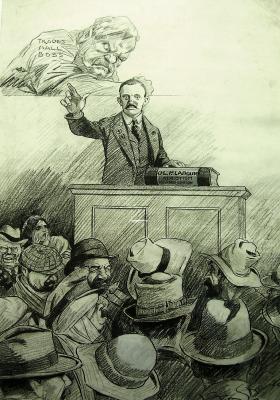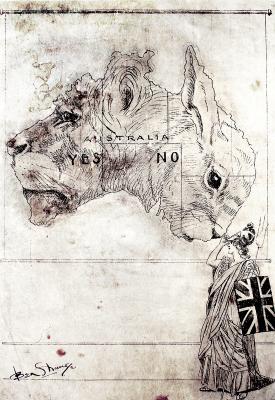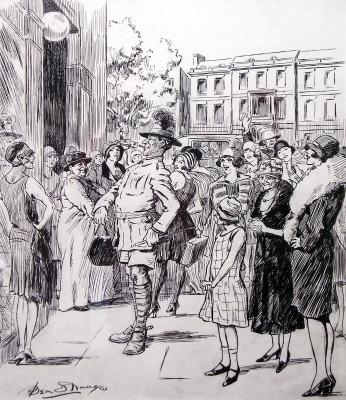CARTOON - WHEN CONSTABULARY DUTYS TO BE DONE - A POLICEMANS LOT IS NOT A HAPPY ONE
1923Scene of a policeman with [LEAGUE OF NATIONS] written on his belt looking at a woman in a white robe with a belt with [PEACE] written on it. She is holding her hands out to her side. They are standing on a street, in the background is a wall with trees behind it and the front of a building on the left side. Behind them on the street are two men. One is bending down with his head buried in the sand of the road with a hat in front of him with [GREECE] written on it. The second figure is in white clothes and wearing a large brimmed hat with [ITALY] written on it. He is holding a pistol in one hand and a sword in the other.
Ben Strange signature bottom right corner
When the cartoon was published in the Western Mail on 13 September 1923 it included the caption :
The German Chancellor (Dr. Stresemann), in "Die Zeit," discussing the question of Germany joining the League of Nations, said:-"It is obvious that when incidents of real importance arise the League of Nations is simply ignored, and that, as a matter of fact, force continues to be the determinative factor."-(Cable.).
"When Constabulary Duty's To Be done, to Be Done. A Policeman's Lot is Not A Happy One" - ("The Pirates of Penzance.")'
The cartoon shows a rather befuddled and ineffectual English bobby (representing the League of Nations - see his belt) scratching his head and wondering what to do about the situation unfolding behind him. His ‘Englishness’ is emphasised by the use of a portion of ‘The Policeman’s Song from the Pirates of Penzance in the caption. Meanwhile Peace, dressed as a Greek maiden, holds out her arms and looks beseechingly at the reader, imploring them to do something to ensure peace is maintained. Behind them 2 figures representing Italy and Greece (names on hats) are involved in a stand-off. Italy, dressed as a pirate and wielding a musket and a cutlass, points the gun at Greece (wearing Greek shoes) who has his head in the sand. Greece is at the mercy of the swash-buckling pirate.
The policeman is unable to intervene, ignored by the fighting men.
The image, along with the comment from the German Chancellor, reiterates the inability of the League of Nations, within a few years of its formation, to resolve conflicts between nations.
Analysis:
The League of Nations was formed on 10 January 1920 (the same day the Treaty of Versailles started operating) in order to maintain world peace. It was first mooted at the Paris Peace Conference following WW1 and promoted disarmament, open diplomacy, penalties for countries engaged in war and advocated that negotiation and arbitration be used between nations during times of trouble. It also supported a range of economic and social reforms.
The League had an initial membership of 42 countries, including France, Britain, Australia, Japan, Italy and Greece. Interestingly, despite President Woodrow Wilson being a strong advocate for the League of Nations, the USA never joined. Germany was allowed to join in 1926 (and withdrew in October 1933), and the USSR only joined in 1934.
In the early 1920s the League experienced some teething problems but was generally viewed as successful in dealing with minor disputes. However, by the 1930s its weaknesses became apparent when major powers challenged its authority - for example the Japanese invasion of Manchuria in 1931. It became clear the League had no capacity to enforce its orders, after all it did not have a military force at its disposal. During the course of the 1930s respect for the League declined and it was not even consulted when Germany invaded Czechoslovakia in 1938. The League did not meet after December 1939 and was formally disbanded in 1946.
Given the underlying weaknesses of the League of Nations, Strange’s 1923 cartoon is remarkably prescient. It details a dispute between Greece and Italy in which the League revealed itself as ineffectual.
Known as the Corfu Incident, the origins of the debacle are in a boundary dispute between Albania and Greece. Three Italian officials were sent to Albania as part of a larger boundary commission to resolve the dispute between Greece and Albania. In August 1923 they were murdered, along with their Albanian chauffeur and translator. While it is not known who was responsible for the murders Benito Mussolini, who had become Italian PM in October 1922, blamed the Greeks and demanded, along with an apology and an inquiry, compensation of 50 million lire. A response to the Italian ultimatum was required 24 hours after it was issued on the 29 of August. On the 30 of August the Greek government had agreed to a number of the demands but not all. Consequently Mussolini ordered that the Italian navy bombard the Greek island of Corfu and a few thousand Italian troops were then landed on the island.
Greece appealed to the League of Nations to intervene. Mussolini, however, declared that the League did not have the competence to deal with the issue and that Italy would leave the League if this action was taken. Instead the matter was referred to the ‘Conference of Ambassadors’. The ‘Conference of Ambassadors’ was not a formal part of the League, but instead was an informal meeting of the more important countries in the League. It was only intended to function until the machinery of the League of Nations was established; its influence however extended well after this had eventuated. The ‘Conference of Ambassadors’ made decisions despite its informal status and these decisions were generally acceded to.
On 8 September 1923, the Ambassadors ordered Greece to pay the full amount of 50 million lire demanded by the Italian Government, as well as take responsibility for the deaths. Greece did so, and on 27 September Italian troops left Corfu.
The Corfu Incident showed that the League of Nations had little power to resolve disputes between major and minor powers. Strange’s cartoon, and the German Chancellor in his comment in ‘Die Zeit’, both recognised these shortcomings.
Details
Details
Artist's signature bottom right [Ben Strange]
HIGH
The Ben Strange cartoons are historically significant as they depict many key figures linked to the history and development of both Western Australia and Australia. Political figures who regularly appeared in his cartoon’s included John ‘Happy Jack’ Scaddan, the Premier of Western Australia from 1911 until 1916, and William ‘Billy’ Hughes, the Prime Minister of Australia from 1915 to 1923.
City of Armadale - History House
City of Armadale - History House
Other items by Ben Strange
- CARTOON - TOMMY WALKER- STILL GOING STRONG
- CARTOON - STARVATION IN EUROPE
- CARTOON - LABOUR REFORM
- CARTOON - SIR WALTERS NEW MASH
- CARTOON - THE PREMIERS CONFERENCE BOVRILISED: BUT THE STATES LIVES IN HOPE
- CARTOON - IN TROUBLED WATERS
- CARTOON - THE GREAT PEACE POSTER
- CARTOON - SHE'S COMING! - THE NEW TERROR
- CARTOON - YOUR EYES HAVE TOLD ME SO
- CARTOON - EAST IS EAST AND WEST IS WEST
- CARTOON - THE LONG TREK FROM THE NORTH
- CARTOON - THE DECIDING FACTOR
Other items from City of Armadale - History House
- CARTOON - A LITTLE BABY WITH A BIG BOTTLE
- CARTOON - THAT MALIGNANT GROWTH
- CARTOON - THE WATCH DOG
- CARTOON - THE SIMPLE LIFE
- CARTOON - SANTA CLAUSE AND THE SILVER LINK
- CARTOON - ADRIFT - DROPPING THE PILOT
- CARTOON - IN PRAISE OF BEAUTY
- CARTOON - THE STRANGE ADVENTURE OF LITTLE NOT WANTED
- CARTOON - FINANCIAL RETURN
- CARTOON - ON A GOOD WICKET
- CARTOON - KING COAL'S GROWL
- CARTOON - TRANSFUSION OF BLOOD
Scan this QR code to open this page on your phone ->



